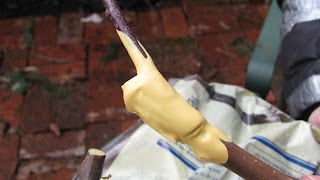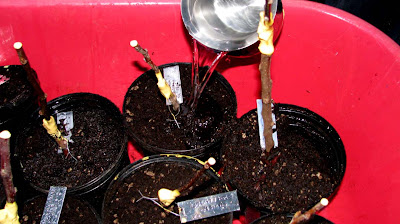Buck wrote about the Home Orchard Society's scion exchange in an earlier post. I had been tracking the exchange in my iCal for months because this will be the first year we have plenty of room to plant any fruit tree my heart desires, and I knew my heart desired a LOT of different trees.
We have gone to 3 or 4 exchanges,
since we first became members 16 years ago, so I had an idea of what we were walking into but when we arrived, I almost had to turn around and go home. It was crazy in there! Apparently there has been a huge upsurge in interest, because we have never seen such a crowd at the scion exchange before.I have to hand it to the HOS for their amazing ability to stay so organized and cheerful under such pressure. There were several local experts on hand to answer questions, give advice and keep the wild eyed beginners on track.
We had a fun visit with a gal and her 92 year old father (who didn't look a day over 70) about all the trees he had grafted and grown, while we waited in the long, circuitous line to purchase rootstock for our 5 pear and 10 apple scions.
We had forgotten to bring masking tape and a pen to mark the names of our scions but everyone shared their supplies happily. It was really a great event.
Now that we had all the rootstock and scions we had to graft them!
 |
| These are scions Buck collected off of our 70 year old Gravenstein tree at our old house. We love the tree and apples from it so much we want more of them. |
I had done a few grafts once before, with about a 30% success rate. That doesn't sound so good but I had only read how to do it in books so I don't think that is too bad. There was a class on grafting at the local Community College in February and June and Buck went to get some hands on practice.
With the knowledge between the three of us we are hoping we will have a better success rate.
We tried to get the process down in photos so that in case anyone is wanting to try it themselves they can get an idea of what is involved.
We have found that it is pretty straight forward and not all that complex, it just takes a little practice. Do yourself a favor and get a bunch of scions from an old apple tree to just make practice graft joints. Do 8 or 9 really good joints before you move on to your precious scions and root stock.
Here is a page from the Home Orchard Society called "Building a Tree". It has a great overview of grafting.
Just click twice on any of the photos and they will get much bigger.
 |
| Do not attempt any grafting without this finger guard made of cardboard... |
 |
| so you do not continue the cut through your finger. Fingers, unlike branches, do not grow back. |
 |
| Our root stock was a lot bigger caliper than our scions, so June and I decided to do a "cleft graft" method. You cut a slice into the side of the root stock. Keep the roots on the root stock damp by keeping a plastic bag around its roots. Don't let them dry out or you will lose the tree. |
 |
| We found that a chisel worked much better for making the cuts on the scion. |
 |
| Cut both sides of the scion to make a wedge that matches the angle of the slice you made in your root stock. |
 |
| Here is the grafting side of a nearly perfect cleft graft. This side has the cambium perfectly lined up. The other side... |
 |
| will not line up. That is the way you need it to be. The side that you lined up will join and heal over the entire graft. |
 |
| This is another picture of the graft side. We forgot to take the finger guard off of the rootstock and had to cut it off to save the graft. Doh! |
 |
| After you make the tight graft joint, wrap it tightly in paper tape. Only use paper tape which will fall apart when the tree gets older. Stronger tape will girdle your tree and kill it. |
 |
| Make a label that will not fade, fall off or otherwise get lost. It would be very sad to not be able to identify your tree in 2 or 3 years, just when it gets going. |
 |
| Don't let this picture confuse you. The stick in the grafting glue is just for glopping the glue onto the grafts. |
 | |
| After you make a tight wrap with paper tape, cover the entire graft and tape with grafting glue. Be sure to cover the cut end of the root stock. |
 |
| Set the grafted tree into its pot while you do the rest of your grafts. |
 |
| Pot up your new tree, being very careful not to bump the little scion. I am doing the wrong thing here, never hold the tree by its scion. I should be holding it by the rootstock. |
 |
| Center the tree and firm in the soil. Again I am holding the scion, a no no. I hope this tree makes it even though I did that. |

 | ||||||||
| Now that we are sure we don't need to redo any of the grafts we can trim the scions down to 2 or 3 buds. We cover each scion tip with grafting glue to keep them from drying out. |
 | ||
| Put your new, little trees in a sunny and safe place. They are delicate for the first year and the scions can be easily dislodged if they are bumped or a bird lands on it. |
 |
| Hooray! The first sign of a successful graft is the budding out of the scion. This is a Clapp's Favorite pear. |
Keep them well watered for the first year. You might need to re-pot them if they outgrow their pots.
You absolutely do not want your trees to get pot bound. The roots that circle around the inside of the pot will later continue around the tree in the ground and will sometimes girdle the tree and kill it years later. (this will happen to other trees you buy too, so cut off or straighten any circling roots.
You can put your baby trees in the ground on their second year, so there is a lot of time invested in a grafted tree. The upside is that each tree cost us only the $5 that we paid for the root stock. We also now have several tree types that we would not be able to purchase anywhere else.
Here are some of the trees we now have:
Pears:
Butirra Precoce Morettini
Clapp's Favorite
Apples:
Goldrush
Pumpkin Sweet
William's Favorite
Pink Wood ( I cannot find an online description, it is a pink fleshed apple)
Gravenstein
King of Thompkins County
There are hundreds of varieties of pears and apples, many of which are nearly extinct. For an over veiw of a few go to All About Apples.
Clapp's Favorite
Apples:
Goldrush
Pumpkin Sweet
William's Favorite
Pink Wood ( I cannot find an online description, it is a pink fleshed apple)
Gravenstein
King of Thompkins County
There are hundreds of varieties of pears and apples, many of which are nearly extinct. For an over veiw of a few go to All About Apples.











Awesome post! I have always wanted to know how to do this and this was a great lesson! Now it's time to find more acreage to plant some trees! ~ Holly's Husband... ;-)
ReplyDelete..yes, great post! Dunno if I had mentioned but we are thinking of getting some fruit trees and I was just talking to A* the other day about grafting! Now I know where to go when I get to the point of grafting onto our apple trees..once we get our apple trees..after we clear the land where the trees will go...and level it off..hopefully by 2014. ;) Do you normally buy the root stock at the same places you would buy trees from?
ReplyDeleteThanks "Holly's Husband" (we'll call you HH for short) and eagergridlesbeaver, I'm glad it was helpful. I will be the first to admit that there are a few things I glossed over that you will need to learn about if you do graft.
ReplyDeleteThe different types of root stock is the first thing, there are a few to choose from. Then there are the several types of grafts- I just showed the two that we used, there are more. Including one to rejuvenate an old tree!
Then there are the more subtle points. For instance if you graft more than one variety of apple onto one tree- let's say a four-way espalier- you will need to choose your varieties carefully so that no one of the varieties is much more vigorous than the others or it will eventually take over the tree. The bigger a graft gets, the more sap it sucks up and the more leaves it makes to hog the sun, leaving weaker varieties to languish and die off.
But the great thing about it is that you can have great success with just the basics.
As far as buying root stock, it needs to be bought in the winter and you want to be sure that it is a reputable source- no disease and the variety you wanted (you will not find out if it is sick or the wrong one until you have invested years into your tree)
I have always bought mine at the Home Orchard Society events. That way I know they are good.
Home Orchard Society is really worth joining, it is an amazing source for information (even if you just read their news letter) and the people are so incredibly generous and helpful.
Isn't grafting fun? Anyway, I may be mistaken, but judging by the way buds are pointing, it would appear that the scion in your "proper whip and tongue" picture was grafted upside-down.
ReplyDeleteBest wishes, and I hope you'll keep us posted on how well things take!
Hi eris, Yes the "proper whip and tongue" is pointing the wrong way because we were just practicing at that point so we were just using what we had laying around - But good eye! Is it too confusing? Maybe I should replace that photo...
ReplyDeleteWhat a fantastic post!!
ReplyDeleteHi there pheobe et al - what a great post and photos! i found you via a google search for images of scion collection, because i need photos for the upcoming issue of the HOS Pome News. any chance you'd be interested in sharing some of your photos (and maybe whole blog posts down the road) for the january issue? please email me:
ReplyDeleteeditor at homeorchardsociety dot org
thanks, and hope to hear from you! karen t.
Hi Karen, We are honored to have you use our posts! We love the Home Orchard Society.
ReplyDelete